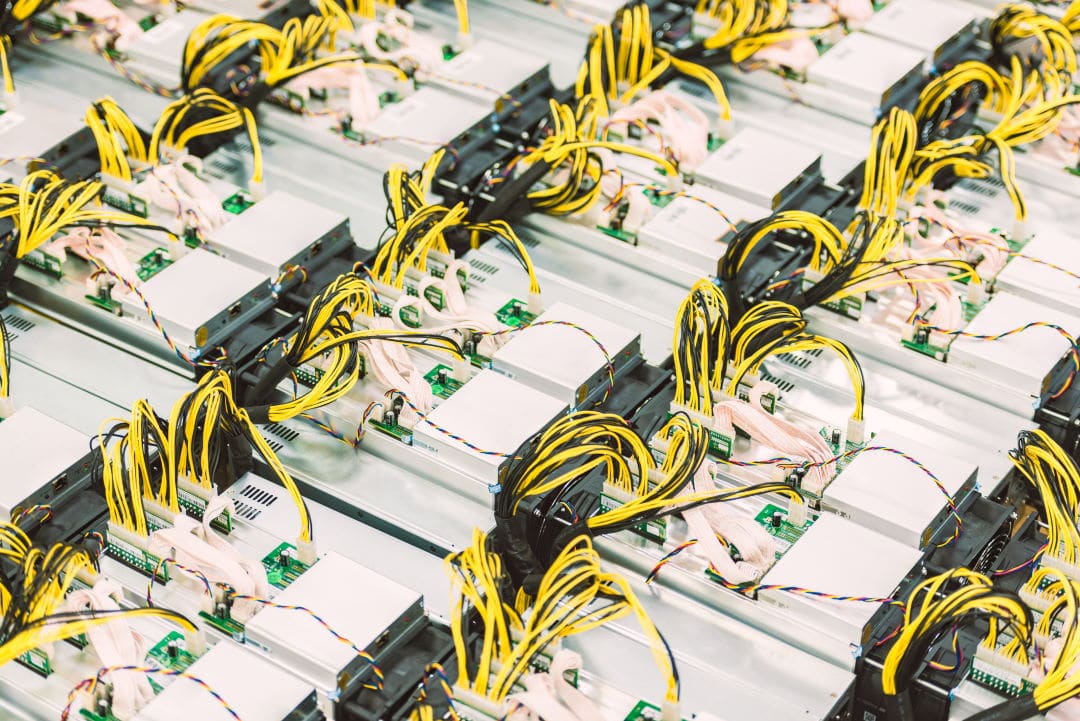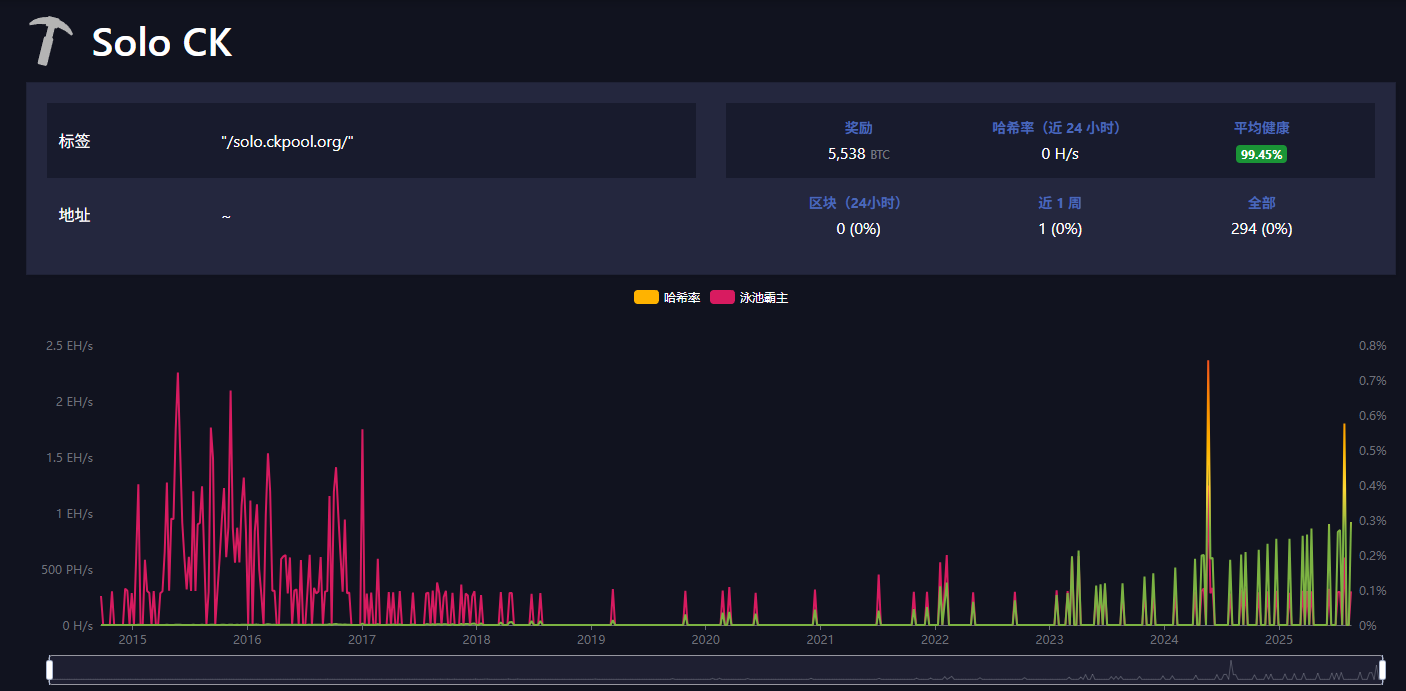Written by: Luke, Mars Finance
In the Bitcoin network, built by billions of machines and processing hundreds of quintillions of calculations per second, an event occurred that is statistically "impossible." Block height 912632 was successfully packed, and the reward worth over $340,000 did not flow to any large mining pool but was completely captured by a node mining through the well-known independent mining service platform Solo CK Pool.

When this news spread across the "information highway" of the crypto world, it brought not only envy for the lucky but also a complex emotion mixed with wonder and nostalgia. It seemed like an unexpected victory of a workshop amidst the tide of industrialization, a wildflower quietly blooming in a sea of steel. In today's world of increasingly concentrated computing power, the ownership of this one block echoed like a distant sound, pulling people's thoughts back to a simpler, purer, and more idealistic "Genesis era."
The charm of this story lies in the low probability of its occurrence. To truly understand this, we must first measure the scale of this "miracle" with numbers.

Currently, the total Bitcoin network hashrate has been maintained above 600 EH/s for a year. What does 1 EH/s mean? It is 10 to the power of 18 hashes per second, which equals 100 billion billion calculations per second. The miner in question was most likely using one or several top-tier ASIC mining machines. Taking the latest Bitmain Antminer S21 as an example, its hashrate is about 200 TH/s (200 trillion hashes per second).
A simple calculation yields: (200 * 10^12) / (600 * 10^18) ≈ 0.00000033.
This means that within any block cycle (about 10 minutes), the probability of successfully mining a block is approximately one in three million. Cryptocurrency thinker and educator Andreas M. Antonopoulos once tried to describe this difficulty with a metaphor: "It's like asking you to find a specific atom somewhere in the entire solar system, and you have to find it within ten minutes."
However, the Bitcoin protocol has preserved a spark for this "impossible task."
The Afterglow of the Golden Age: From "One CPU, One Vote" to Hal Finney's Warm Breeze
Back in 2009, when Satoshi Nakamoto released the Bitcoin white paper, the envisioned consensus mechanism was named "Proof-of-Work." Its core idea, as stated in his mailing list, was to build a "peer-to-peer system based on CPU computing power," achieving a decentralized vision of "one CPU, one vote."
In this "pastoral era," mining resembled an intellectual game and a social experiment. The legendary figure Hal Finney, who was the first person to receive a Bitcoin transfer, tweeted a historically significant message on January 11, 2009: "Running bitcoin." He later recalled on a forum, "When I was the only person running the Bitcoin program besides Satoshi, my computer mined quite a few blocks in just a few days… But the noise from the fan and the heat from the computer eventually made me turn it off. Looking back, I really wish I could have kept it running."
The "fan noise" that Finney was troubled by at the time now seems like a luxurious concern. Independent mining was the norm then, the original intention of the protocol design. Every early believer who participated with their personal computers was a guardian of the network and a potential beneficiary. However, as Bitcoin's value was discovered, this peaceful experiment quickly evolved into a silent "arms race."
The curtain on this change was raised by a programmer named Laszlo Hanyecz — yes, the same person who famously bought two pizzas for ten thousand bitcoins. In 2010, he was the first to realize that graphics processing units (GPUs), with their hundreds of parallel processing cores, were far more efficient than CPUs in executing Bitcoin's hashing algorithm. He successfully wrote the first GPU mining program, inadvertently opening the "Pandora's box" of specialized mining.
The entry of GPUs quickly made CPU mining a thing of the past. What truly pushed this competition to the peak of industrialization was the birth of ASICs (Application-Specific Integrated Circuits). These chips were designed solely to execute Bitcoin's SHA-256 algorithm. Their emergence completely declared the end of the personal computer mining era, raising the computing power threshold by tens of thousands of times.
The Era of Whales: The Rise of Mining Pools and the Choices of Individual Miners
The advent of ASICs was like introducing tanks into the era of cold weapons. Massive capital began to flow in, and in areas with cheap electricity, "mining farms" composed of thousands of ASIC miners sprang up, with the roar of machines replacing Finney's fan noise, becoming the background sound of the Bitcoin network's heartbeat.

Faced with such a barrier of computing power, individual miners with a small number of mining machines found that they might go years without the luck to find a block. The extreme uncertainty of income gave rise to a crucial invention in the Bitcoin world — Mining Pools.
The logic of mining pools is simple: "Many hands make light work." It acts like an open alliance, allowing miners from around the world to connect their computing power to a common server. Everyone "guesses" together; regardless of which machine in the alliance guesses the answer correctly, the block reward will be distributed according to each member's contributed computing power.
Data from the Cambridge Centre for Alternative Finance (CCAF) shows that over 95% of Bitcoin's total computing power is now concentrated in major mining pools, such as Foundry USA and AntPool. Joining a mining pool means giving up the chance to receive the full block reward in exchange for stable, predictable "labor-distributed" income. This is a rational economic choice, as it greatly smooths the income curve and reduces uncertainty.
Thus, independent mining (Solo Mining) has transformed from a norm into a near-religious persistence.
Deconstructing Solo CK: The Army Behind a Name
In discussing the victory of this anonymous miner, one name repeatedly appears, sparking curiosity and questions: Solo CK Pool. On block explorers, this name seems to frequently appear alongside "lucky blocks." This naturally raises a core question: Who exactly is Solo CK? Is it an extremely lucky individual or a large entity? Why does it frequently "mine," yet is considered a collection of individual actions?

On its official website, a prominent note reveals its essence: "Please note: Although 'Pool' is in the name, it is not a mining pool; it is a service that allows miners to mine independently…"
This is the crux of the matter. Solo CK is not a cooperative that gathers computing power and shares rewards in the traditional sense, but more like a "gold mining service station." It provides the most advanced tools for those who want to "go it alone" (eliminating the complex technical work of setting up and maintaining a full Bitcoin node), but the miners are still fighting their own battles. Its mechanism is open and transparent: anyone can anonymously point their mining machine to its server; miners use their Bitcoin wallet address as their "username" to log in. This means that when any miner using its service is lucky enough to mine a block, the block reward goes directly into that miner's own wallet. The platform does not handle this large sum at any point, only taking a 2% technical service fee.

Therefore, many blocks marked "Solo CK" do not come from the same entity winning consecutively, but rather from hundreds or thousands of different, anonymous independent miners who just happen to be using the "tools" provided by this platform. The "Solo CK" label on block explorers is more like a "brand certification," proving that another independent gold miner using its service has found their own nugget in this vast digital wilderness.
Even with an understanding of its operational model, a deeper question arises, in line with the crypto world's spirit of "Don't Trust, Verify": Could this be a carefully designed disguise? Is it possible that a large mining pool is playing the role of Solo CK behind the scenes to create a facade of decentralization?
Such skepticism is healthy, but multiple clues, from economic motives to technical evidence, point to a negative answer.
First, the economic motives are completely inconsistent. The core business model of large mining pools is to pursue certainty by aggregating massive computing power to smooth out earnings and earn stable service fees. Their existence is meant to eliminate the element of "luck." In contrast, Solo CK's model serves those willing to embrace extreme uncertainty for a chance at small-probability wealth. A large mining pool disguising itself as Solo CK would be akin to an insurance company opening a casino, which is fundamentally contrary to its business logic.
Second, on-chain data provides the most direct evidence. By tracking the block rewards "mined" by Solo CK, it is clear to see that these bitcoins are sent to a large number of different, unrelated wallet addresses. If a single entity were behind it, we would expect to see these funds systematically consolidated into a few addresses shortly thereafter, but this has not happened. The subsequent flow of these funds exhibits characteristics consistent with the decentralized and unordered behavior of thousands of independent individuals.
Finally, the project's reputation provides indirect corroboration. The founder of Solo CK Pool is Con Kolivas, a well-respected developer in the tech community. His motivation for creating this platform stems more from a sense of technical idealism and support for ordinary miners, and his website clearly states its "not-for-profit" nature.
Thus, Solo CK's frequent appearances in the public eye do not prove centralization; rather, they illustrate that even in today's highly concentrated computing power landscape, there are still many steadfast individuals quietly engaged in a lonely yet great probability game.
The Ultimate Victory of the Law
When we clear away all the fog and revisit the success of block 912632, its significance becomes even clearer.
The victory of this anonymous miner is not just an isolated lucky event but the highest praise for the Bitcoin protocol's foundational stability. The core of Proof-of-Work is not "the strong get stronger," but "probability fairness." The advantage of mining pools lies in their ability to roll the dice billions of times per second, while independent miners may only roll a few times. However, the Bitcoin protocol has never deprived anyone of the right to roll the dice; as long as you follow the rules, every calculation is an equal attempt recognized by the network.
In January 2022, a miner with only 126 TH/s managed to mine a block through Solo CK Pool, echoing today's event. Together, they prove that no matter how tall the skyscrapers (giant mining farms and pools) built on the ground, the cornerstone of the Bitcoin protocol remains unshakable.
It declares to every potential participant: the door to this system is still open to you, no matter how small you are; as long as you are willing to contribute your computing power, you are an equal part of this network and will always retain the possibility of creating miracles.
This, perhaps, is the most valuable insight brought by this $340,000 block.
免责声明:本文章仅代表作者个人观点,不代表本平台的立场和观点。本文章仅供信息分享,不构成对任何人的任何投资建议。用户与作者之间的任何争议,与本平台无关。如网页中刊载的文章或图片涉及侵权,请提供相关的权利证明和身份证明发送邮件到support@aicoin.com,本平台相关工作人员将会进行核查。




